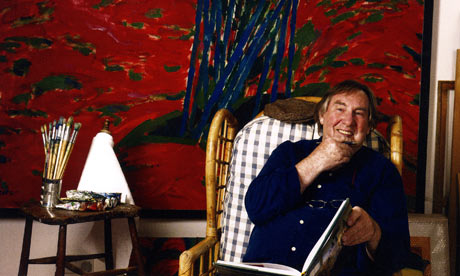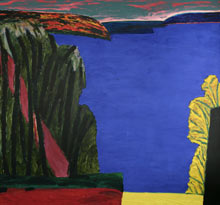Scots-Irish painter inspired by Picasso, who imbued landscape with vivid colour

Crozier painted many of his most intensely coloured landscapes at dusk.
On graduating from Glasgow School of Art in 1953, William Crozier, who has died of cancer aged 81, went to Paris, took digs in St-Germain-des-Prés and stayed for a little over six months. He never lived there again but, spiritually, he never departed. "To be in Paris then was to be at the centre of the world," he recalled, and added: "Anyone who was not young [then] and did not sit in the Café Flore or the Deux Magots, where Sartre and Simone de Beauvoir were as gods, simply cannot imagine the excitement that enveloped the young of Europe, emotionally, physically and intellectually." What is peculiar about this enduring attachment is that by the end of the 1950s Paris was no longer the centre of the world and, even though in 1979 Crozier paid an extended visit to the self-appointed new capital, New York, its main effect was to reaffirm his rootedness in European culture – though he loved the freedom of Willem de Kooning's painting. What the gods of the Deux Magots had bestowed on Crozier (through printed texts: he never screwed up the courage to speak to Sartre or de Beauvoir) was existentialism, the root assertion that every man is responsible for his own freedom. In his painting, Crozier saw each fresh canvas as a totally new challenge, and if the very first brushstroke felt wrong, he binned the canvas. His very early work does not indicate anything like the heights to which he would rise. At a glance, his work might seem to follow in the steps of the Scottish colourists, but actually it was much meatier than the painting of JD Fergusson (who met and encouraged the young tyro), SJ Peploe, FCB Cadell or GL Hunter ever was. Nor was Matisse much of an influence, though Crozier recognised that he was a giant. It was Picasso whom Crozier admired with a passion, Picasso's energy on which he drew, though after Crozier's jejune but maybe necessary attempts in 1950 to absorb the influence, the outward lineaments of Picasso's work were never again obvious in his painting. Crozier was born in Glasgow, the son of working-class parents, his father a plumber in Stephen & Sons' Govan shipyard. From the age of 12, the boy received a good education at Marr college in Troon, and made a lifelong friend in William Irvine, who from 1947 would accompany Crozier on explorations of the art of Paris, where on their first visit they camped out in a tented village intended for refugees. 

Crozier: Departure from the Island, 1993.
Together they graduated from Glasgow School of Art, went to London, and knocked about in Soho making friends. Life in these years was tough, but in 1954, on a visit to Glasgow from London, Crozier met the actress Elspeth McKail, married her, and together they went to Dublin, where he painted backdrops at the Olympia theatre. Back in England in 1956, he and Elspeth set up home in Folkestone, Kent, with their young son Paul, named after Paul Éluard, the Parisian surrealist poet. In 1957, with Irvine and a third artist, John Wright, Crozier had his first show, at the Parton Gallery, in Greek Street, Soho. The following year saw Crozier's breakthrough: he found a studio in Essex, at Pebmarsh, and here he painted a series of dark, dramatic landscapes, sun like a cannon shot in a milky yellow sky, battered black crops streaked blood-red, yellow ochre and earth colours that refuse to stay earthed. The confident aspiration of these canvases set him up for life; and in the same year Halima Nalecz invited Crozier and Irvine to show at the Drian Gallery in Porchester Place, which she had founded precisely to show the work of abstractionists or near-abstractionists who were being ignored by the establishment. Soon afterwards, Arthur Tooth & Sons came calling. Crozier accepted and began showing at Tooth's in Bruton Street, probably the gallery of modern art with the highest prestige in town at the time; but he continued to exhibit at the Drian, and Nalecz was keen enough on his work to give him not only a contract but also the rental on a London studio. Despite the ferocious brushwork and sombre colours of the Essex farmland paintings, it became clear that colour was the name of his game. Even so, dusk was his favoured time of day, with paintings of Gramercy Park, New York, or Lough Hyne in County Cork, glowing with dense blues as effulgent as the Provençal canvases lit by the noonday sun. Crozier's parents were originally from County Antrim and he would say that he felt more Irish than Scots. He became an Irish citizen in 1973 and lived by Roaringwater Bay in West Cork for large parts of the year. Here he felt the landscape had never been painted by anyone before him. He had a home in Hampshire too, and while he was head of painting at Winchester School of Art met and married (his first marriage having ended in 1965) the art historian Katharine Crouan. She became his manager and edited the magnificent monograph on Crozier published in 2007. He is survived by Katharine and by the son and daughter of his first marriage, Paul and Siobhan. • William John Crozier, artist, born 5 May 1930; died 12 July 2011
No comments:
Post a Comment